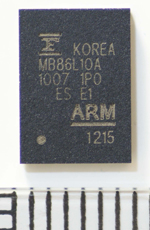
| Home | About Us | Contribute | Bookstore | Advertising | Subscribe for Free NOW! |
| News Archive | Features | Events | Recruitment | Directory |
News
3 June 2010
Fujitsu launches first 3G and LTE SAW-less transceiver
 Fujitsu Microelectronics America Inc (FMA) of Sunnyvale, CA, USA has made available samples of what is claimed to be the first transceiver that supports 3GPP LTE/WCDMA/EGPRS wireless phones.
Fujitsu Microelectronics America Inc (FMA) of Sunnyvale, CA, USA has made available samples of what is claimed to be the first transceiver that supports 3GPP LTE/WCDMA/EGPRS wireless phones.
Following the launch last September of the MB86L01A (the first commercial multimode 2G/3G SAW-less transceiver), the new MB86L10A transceiver eliminates 3G and LTE TX and RX inter-stage surface acoustic wave (SAW) filters and low-noise amplifiers (LNAs). The single-chip transceiver features backward compatibility with a high-level programming model (API) for radio control using DigRF/MIPI D3G and D4G open-standard digital interfaces, making compatible with a wide range of industry basebands.
Manufactured in 90nm CMOS silicon process technology, the compact module (in a 230-pin, 6.5mm x 9.0mm x 0.9mm LGA package) enables cell-phone makers to reduce component count, board space and total bill of materials, the firm says. The simplified programming model also significantly reduces development time and simplifies integration of the RF in a radio platform. The transceiver, which is optimized for compressed mode operation, features quad-band GSM/EDGE and up to five WCDMA or LTE bands in a single-phone configuration.
The MB86L10A includes eight outputs that directly drive the power amplifier, eliminating the need for TX SAW filters while simultaneously supporting advanced multimode PAs. The receiver provides nine inputs that support LTE, WCDMA and GSM/EDGE. The new RF front-end eliminates the need for LNAs and SAW filters. Five additional ports enable RX diversity in WCDMA and LTE modes. The receiver also incorporates anti-aliasing filters, digital channel filters, digital gain control and high-dynamic-range ADCs.
The MB86L10A supports GSM (GSM850, EGSM900, DCS1800, PCS1900), WCDMA (bands I, II, III, IV, V, VI, VIII, IX, X and XI) and LTE (FDD bands 1, 3, 4, 6, 7, 8, 9, 10, 11, 13, 17 and TDD band 38 or 40). The transceiver includes dual 3G and 4G DigRF interfaces to the baseband IC to support the latest as well as legacy generations of basebands, SPI and/or GPOs control PAs, switching regulators and antenna switches. A microcontroller in the transceiver simplifies timing and control.
“The Fujitsu MB86L10A LTE multimode transceiver is the first of its kind to eliminate LNAs and 3G/4G TX and RX SAWs, reducing board area, component count and cost,” claims Vivek Bhan, senior director of RF Engineering and Product Development for Fujitsu Microelectronics America. “This LTE multimode RF transceiver supports most global band configurations and standard interfaces, and its simple RF API programming reduces radio integration time,” he adds. “The result is smaller radios with optimal time to market for handset manufacturers worldwide.”
The MB86L10A transceiver is in the pre-production phase and is supporting field trials at a major carrier. The field trial is exercising the new device in 2G, 3G and 4G modes across multiple bands and both DigRF interfaces. “Early feedback on an advanced new standard will help develop a stable product faster, speeding time to market,” says Bhan.
![]() Search: Fujitsu Transceiver
Search: Fujitsu Transceiver
Visit: www.fujitsu.com/us